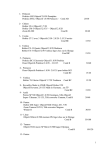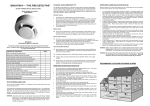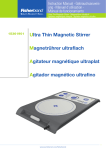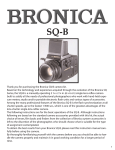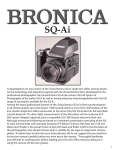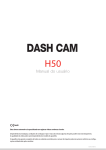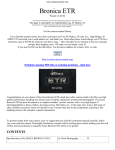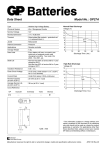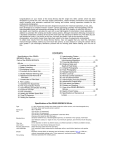Download Bronica ETR-S Instruction Manual
Transcript
ETRS Congratulations on your choice of the Zenza Bronica ETRS single lens reflex camera, which will offer you high quality performance, handling convenience and versatility required for professional photography. The Zenza Bronica ETRS has been developed as a "system" camera, with a very high degree of interchangeability. The Zenza Bronica ETRS is backed up by a full range of valuable accessories, which permit use in many other day-to-day assignments, which require a fast-handling camera with complete exposure automation. Although instructions described in this booklet are based on a standard combination consisting of the ETRS main camera body with standard Zenzanon-EII 75mm lens, Film Back ETRS 120 and Waist-level finder E, these lenses, film back and finder are left to your discretion to select such items best suited for your picture taking. To get best results from your camera, we suggest that you read this instruction manual carefully, before you even touch the camera. 1 Contents Specifications of the ZENZA BRONICA ETRS Parts of the ZENZA BRONICA ETRS 1. 2. 3. 4. 5. 6. 7. 8. 9. 10. 11. 12. 13. 14. 15. 16. 17. 18. 19. 20. 21. 22. 23. 24. 25. 26. 27. 28. 29. Loading the Battery Battery Checking Attachment and Removal of Film Backs Construction of Film Back Film Loading Film Type Indicator Frame Film Advance and Shutter Cocking Exposure Counter Film Unloading Setting the Shutter Speed Dial Shutter Release Button Time (T) Exposure Exchanging Lenses Interchanging Lenses Waist-Level Finder and Interchanging Magnifiers Setting the Aperture Focusing Adjustment Distance Scale and Depth of Field Scale Infrared Photography Flash Photography Multiple Exposures Interchanging Focusing Screens Attachment of Neck Strap Facts about the Battery Pointers on Shooting Care and Maintenance Depth of Field Tables Interchangeable Lenses Accessories for Increasing the Versatility Page 3, 4 5 6 6 6, 7 7, 8 8, 9, 10 10 10 10 11 11 12 13 13 14 14, 15 15 16 16 17 17 17 18 18, 19 19 20 20, 21 22 23, 24 25 2 Specifications of the ZENZA BRONICA ETRS Type 4.5cm x 6cm format lens shutter single reflex camera, with interchangeable lens, film back, finder and focusing screen systems. Frame Size 42.5mm x 55.1mm (side/length ratio of 1:1.29 closely matches standard paper and reproduction sizes.) Film 120 roll film (15 exposures); 220 roll film (30 exposures); 135 cartridge loaded film; and Polaroid® Land pack films. (Exclusive film backs for each film type) Standard Lens Zenzanon-EII 75mm F2.8, interchangeable type; 6 elements in 4 groups; multi-layer anti-reflection coated; 49° angle of view, F22 minimum aperture, helical focusing from inf. to 60cm. Filter Size Ø62mm for 4-250mm lenses and Ø95mm for 500mm lens. Lens Mount Exclusive four claw Bronica ETR bayonet mount. Lens Diaphragm Fully automatic instant re-opening lens diaphragm action; equal-distant aperture scale graduations; depth of field previewing. Shutter Electronic control SEIKO #0 between-lens leaf shutter; shutter speeds 8 sec. to 1/500 sec. plus T (time exposures); intermediate settings are not possible, mechanical control setting 1/500 sec. Multiple Exposure Multiple exposures possible with lever on main body. 3 Specifications of the ZENZA BRONICA ETRS (con’t) Film Back Daylight loading interchangeable type; Exclusive film backs for 120, 220, and 135 cartridge loaded films and Polaroid® pack film. Finder System Interchangeable finder system, with choice of five optional finders or Waist-Level Finder E, AE (automatic exposure)-II finder E, Rotary Viewfinder E, Prism Finder E and Sports Finder E. (No standard finder is supplied and, therefore, a suitable one must be ordered separately.) Focusing Screen Interchangeable type. Standard screen has diagonally-oriented split-image rangefinder spot surrounded by microprism ring and full-area matte screen. For optional screens, please see 22. Interchanging Focusing Screens. Flash Synchronization X-setting (up to 1/500 sec.) Battery Checking Red-colored LED lights up within screen area when battery check button is depressed, if there is sufficient power; also LED flash signals upon closing of shutter blades. Battery Single 6-volt silver oxide or alkaline battery also powers AE-II finder E, when attached. Dimensions 91 (wide) x 107 (high) x 165 (long) mm (With Zenzanon-EII 75mm lens, Film Back ETRS 120 and Waist-Level Finder E.) Weight 465 grams (ETRS Main body only; without battery) 1,280 grams (With Zenzanon-EII 75mm lens, Film Back ETRS 120 and Waist Level Finder E; without battery.) 4 Parts of the ZENZA BRONICA ETRS Flash synch socket Aperture ring Depth of field scale Distance scales Focusing ring Lens alignment dot Focusing hood/magnifier catch Waist-level finder Shutter speed dial Shutter speed scale Magnifier Finder release button Back cover release button (left) Shutter release button Back cover release button (right) Exposure counter Depth of field preview lever Multiple exposure lever Neck strap stud Battery check button Film winding crank Dark slide slit Film plane mark Manual film winder Flash synch contact Speed Grip shutter release connection Motor drive contacts Shutter release button locking ring Lens release button Cable release socket Film back release button Spool holders Neck strap stud T (Time) exposure lever Setscrew Film type indicator frame Tripod mounting shoe Tripod socket (1/4” screw) Battery chamber cover Battery chamber button 5 1. Loading the Battery The electronically controlled shutter will not work without loading the battery. The shutter will be mechanically controlled when the battery is not loaded or when it is loaded with its polarity marks reserved. It will then be released at 1/500 sec., regardless of the setting on the shutter speed dial. Your camera is supplied with an alkaline battery. For longer performance we recommend a silver oxide battery (Eveready No. 544, UCAR No. 544 or Duracell No. PX-28.) A. Depress the battery chamber button with your finger and at the same time, move the battery chamber cover in the arrow-indicated direction. The cover will come off easily. B. Coincide the plus (+) and minus (-) marks on the battery with similar polarity indications in the battery chamber. Then, push the negative end of the battery first and follow with the positive end. Insert the BATTERY end of the battery chamber cover, which also has a mark coinciding to that on the body. Then move the cover in the other direction (opposite to the arrow indication) until it locks in place. 2. Battery Checking If a red colored LED lights up in the left-rear corner (of the waist-level finder) when the battery check button is pressed, the battery is loaded properly and there is sufficient power for electronic operations. * If the LED does not light up, (1) the battery is not loaded properly or (2) it is completely drained. 3. Attachment and Removal of Film Back The film back is a film chamber that can be attached or detached freely, thus permitting free exchange of film types even during shooting sessions. The camera main body and film back are fully coupled, upon connection. Therefore, always turn the film-winding crank completely one time, upon attaching the film back. If winding is not possible, all preparations for taking pictures have been completed. But, if winding is possible, rotating the film winding crank until it stops will automatically take care of the incomplete action, whether un-cocked shutter or film not advanced. Thus, it's always possible to choose the film type most suited for the shot, even midway in the roll. 6 3. Attachment and Removal of Film Back (con’t) * Make full use of the interchangeable film back. 1. Color and black-and-white in different film speeds can be shot, as required. 2. Continuous shooting is possible if sufficient preloaded film backs are available. 3. Don't waste unsuitable film used in a previous session but simply load up a new film back with the required film type. 4. Many in the studio or at home can use a single ETRS main body, by using additional film backs. A. To attach the film back to the main body, simply insert the latches at the upper end of the film back into the attachment openings at the upper end of the main body. Then, press the lower end of the film back against the main body until it locks securely. * The dark slide must be withdrawn from its slit, upon attachment of the film back to the main body, as otherwise the shutter cannot be released. B. To remove the film back from the main body, insert the dark slide into the dark slide slit, as illustrated, with the mark on the dark slide at the top end. Push it all the way in. * There is danger of the film back accidentally becoming detached from the main body, should the dark slide be left in its slit while the camera is being carried. Therefore, make it a rule to withdraw the dark slide promptly upon attaching the film back to the main body. C. Depress the film back release button and the lower end of the film back can be removed, as illustrated. Simply shift the film back up slightly and pull it away. * The dark slide can be withdrawn, even while the film back is detached from the main body and, therefore, extra care is required, in this respect. 4. Construction of Film Back A. The film back consists of a film holder and a film back frame, with exclusive film holders supplied for 120 and 220 roll films. The film holder has an insert or frame for loading film, as well as a built-in film winding mechanism. 7 4. Construction of Film Back (con’t) B. The film back frame, on the other hand, consists of a base with a dark slide slit and a back cover with a film type indicator frame. The film back frame completely encloses the film holder and shields it from outside light, as well as connecting it to the camera main body. 5. Film Loading A. To open the back cover, squeeze the left and right back cover release buttons, in the arrow-indicated directions, at the same time and the back cover will open. B. Then, the film holder can be detached. C. There are two spool holders on the film holder. The top one is for the fresh film spool while the bottom one is for the empty take-up spool. The left-side shafts of both spool holders can be opened outward, as illustrated. Therefore, insert the right end on the spool on to the right-side shaft, which is fixed, and then close the left-side holder (shaft), which will engage the spool. * The spool holders on the left side will be locked securely, when the back cover is closed. D. After loading the fresh film spool properly, draw out the leading end of the film and turn it across the film pressure plate (as illustrated). Run it down and turn it over to the take-up spool. Insert the leading end into the slit of the take-up spool and wind slightly until securely engaged. * The inside black surface of the leader must face out when running across the pressure plate, in this case. 8 5. Film Loading (con’t) E. Rotate the manual film winder on the right side of the film holder in the arrow-indicated direction, while checking the advancing film. When the starting point, or arrow-mark, is aligned with the triangular start-mark on the top left side of the film holder, stop rotation. F. The starting point, or arrow mark, can also be aligned with the start-mark, with the film holder loaded in the film back. Simply rotate the film-winding crank on the camera main body, in this case. This method is preferred since there will be coupling with the camera main body mechanism, from the beginning. * If the film is not advanced when the film-winding crank is rotated, the film holder is not inserted properly and/or the camera main body may be set for multiple exposures. In the latter case, return the multiple exposure lever to an upright or vertical position. G. Close the back cover, by pressing it firmly against the base of the film back, as illustrated. The back cover will automatically close and lock, with the safety lock also locking the back cover release button. The same operation will close the back cover when the film back is detached from the main body. H. Upon loading the film, rotate the film-winding crank until it stops to place the first frame into place for taking the picture. The exposure counter will also change from "S" to "1", while the shutter will also be cocked. I. When the film back is detached from the main body for film loading, the manual film winder is used for advancing the film. The film will stop when it is in place for the first exposure, with the exposure counter also changing to "1". However, it will be possible to rotate the manual film winder, and, therefore, it should be rotated 2 or 3 times more, in order to take up any slack in the loaded film. 9 5. Film Loading (con’t) When loading 220 roll film in it's exclusive film back, do not mistake the dotted line for the starting point, as it is located before the arrow marks. * See the instructions supplied with Film Back ETRS 135 for proper use of the 135 cartridge loaded film. 6. Film Type Indicator Frame Upon loading the film, tear off the end flap from the empty film package and insert it in the film type indicator frame. This will help you keep track of the film loaded in the film back and should prove useful when two or more film backs, with different types of films are used. 7. Film Advance and Shutter Cocking Rotating the film-winding crank completely one time, in the forward direction, will advance the film one frame and, at the same time, cock the shutter, with the winding action stopping automatically. On the other hand, short, rapid strokes, up to an accumulated full rotation, will also do the job. 8. Exposure Counter The exposure counter shows the number of frames exposed or, in other words, is an additive type. Starting from "S", the counter on Film Back ETRS 120 shows numbers from 1 to 15, while Film Back ETRS 220 shows numbers from 1 to 30. 10 9. Film Unloading A. After the 15th exposure of the 120 roll film (30th exposure of the 220 roll film), the film-winding crank will turn freely with further rotations. Therefore, continue rotating the film-winding crank until the remaining film and all leader paper is wound up on the take-up spool. Open the back cover when winding action becomes very light. B. Remove the film holder and, while preventing the loose film from unwinding, take out the take-up spool. Seal the exposed film and return it to its original box until development. * Always load 120 roll film in Film Back ETRS 120 and 220 roll film in Film Back ETRS 220. * Load and unload film away from direct sunlight and/or strong illumination. 10. Setting the Shutter Speed Dial A. The shutter speed scale is viewed in its window over the shutter speed dial. Numbers 1 to 8S are full numbers and 2 to 500 are fractions of a second. Thus, "8S" is 8 sec., "2S" is 2 sec. and "500" is 1/500 sec. Intermediate settings are not possible. * The shutter is only released at 1/500 sec., when the battery is not loaded or is completely drained. B. Red-colored numbers on the scale are full number settings of 1 second and longer while white-colored numbers are settings from ½ to 1/500 second. See 12. Time (T) Exposures. There is no bulb (B) setting. The shutter speed setting can be changed before or after the film is advanced. 11 11. Shutter Release Button A. Depress the shutter release button with the ball of the finger. Press all the way in with a smooth and gentle action. There is no need for strength or jerky action, which will induce camera shake and affect picture sharpness. * A red-colored LED will flash briefly in the left-rear corner of the waist-level finder, when the leaf shutter closes and the shutter action is completed. B. Safety Lock- The shutter release button has three settings to which it can be set by rotating in the clockwise direction. Two of these settings have safety-locking features of slight difference. The three positions are indicated by the red dot being placed at the bottom, at a position of 45° from bottom setting and at the side, with functions differing as per table. Release with Shutter release button red dot positioned at Bottom Shutter release button Motor Drive E & Speed Grip E release button Cable release button Releases Releases Releases 45° left Locked Releases Releases 90° left Locked Locked Locked Remarks: Use Motor Drive E with red dot positioned at 45° left. The shutter cannot be released, in the following cases: 1. Shutter release button is locked. 2. Dark slide is inserted. 3. Film winding crank has not been rotated fully. (Same when the exposure counter is still between "S" and "1".) 4. Shutter is not cocked. 5. Lens is not properly attached. (Same with extension tubes and bellows.) 6. Lens release button is being depressed. 7. All frames (15 on 120 roll film and 30 on 220 roll film) have been exposed already. * If film-winding crank is rotated while depressing shutter release button, the shutter will be released when the winding action is completed. * A cable release or self-timer can be used with the cable release socket on the main body. 12 12. Time (T) Exposure Time exposures are made with the time exposure lever on the lens, regardless of the setting on the shutter speed scale. However, the lever is locked to prevent accidental movement and must be unlocked for use. A. Unscrew the set screw on the time exposure lever until further revolution is not possible, which will permit the lever to be moved freely. * Except for time exposures, always shift the time exposure lever so that "A" is visible on the lens barrel and keep it locked with the setscrew to prevent accidental movement. B. Next, cock the shutter with the film-winding crank and then shift the time exposure lever to the left (looking from the body towards the lens), which will expose a red-colored "T" on the barrel. The shutter will stay open when the shutter release button is depressed in this condition. Shifting the time exposure lever in the opposite direction and exposing the letter "A" once more closes the shutter. 13. Exchanging Lenses The lens cannot be attached or detached unless the shutter is cocked. Therefore, first, rotate the film-winding crank and cock the lens shutter. A. To attach the lens to the main body, align the red dots on the lens and the main body and then insert the lens fully into its mount. Rotate in the counter-clockwise direction until it stops, with an audible click, which will indicate that it is securely locked. B. To detach the lens while sliding the lens release button backwards, rotate the lens in the clockwise direction until it makes a full stop, at which point it can be detached. 13 14. Interchanging Finders A. The finder can be interchanged with other optional finders to match shooting conditions to photographic conditions. To attach the finder, align the front end of the finder with the front end of the finder frame on top of the camera main body, as shown. Then, gently lower the finder and, when well seated, slide forward until it locks. B. To detach, simply depress the finder release button, while, at the same time, sliding the finder backwards where it can be taken up. 15. Waist-Level Finder and Interchanging Magnifiers A. The focusing hood of the waist-level finder is opened by pushing or pulling up on the focusing hood/magnifier catch at the rear end of the folded waist-level finder. B. The magnifier can be flipped up into viewing position, by simply sliding the focusing hood/magnifier catch in the arrow-indicated direction (to the left). To return the magnifier to its storage position, simply push it down until it catches. C. To close the focusing hood, first, push down the magnifier (if it is flipped up). Next, press in both side frames, as illustrated, and, at the same time, press the front frame back towards the rear end. The focusing hood will automatically be folded down. 14 15. Waist-Level Finder and Interchanging Magnifiers (con’t) D. The standard magnifier supplied with the waist-level finder has a power of -1.5 diopters, which can be exchanged for others with powers of -4.5, -3.5, -2.5, -0.5, and +1.5 diopters. These optional accessories should be purchased to suit the user's eyesight, if necessary. Simply rotate the magnifier frame in the counter-clockwise direction to unscrew. Attach in the reverse manner. 16. Setting the Aperture A. The aperture ring is rotated, in either direction, to set the required f/number opposite the white index dot. The aperture ring click-stops at the numbered settings. Intermediate settings are also possible. * Intermediate settings cannot be used when the AS-II Finder E is used. B. All Bronica interchangeable lenses for the ETRS have fully automatic lens diaphragms, which means that the focusing screen is always viewed at the full aperture, with the brightest possible image. However, depressing the depth of field preview lever will stop the lens diaphragm down to the pre-selected lens opening (aperture), permitting the photographer to check the depth of field effect on the focusing screen. * The aperture ring must not be adjusted while the depth of field preview lever is being depressed. * Furthermore, the depth of field preview lever must not be used for taking an exposure reading, with the AE-II Finder E, in both automatic and manual exposure operations, as the indicated shutter speed setting will not be correct. This is because the Bronica ETRS has been designed for full aperture metering and over-exposure will result, in this case. 15 17. Focusing Adjustments A. The lens is focused on the subject, by rotating the focusing ring in either direction, while checking the effect on the micro-prism / splitimage rangefinder spot in the center of the focusing screen (standard type). B. The central split-image spot splits the image diagonally, with the upper and lower halves being separated diagonally when the lens is out of focus. When in focus, however, the two halves will coincide with the diagonal displacement disappearing. The micro-prism ring surrounding the central spot can also be used for checking the sharpness of the focused image, since the image will glitter when the lens is not focused. The full-area matte surface surrounding the central focusing aids can also be used for checking image sharpness. 18. Distance Scale and Depth of Field Scale A. Distance scales on the Bronica lenses for the ETRS can be used for setting the focus on the required distance or finding the distance actually focused. Simply rotate the focusing ring and set the required distance opposite the green-colored index, which will adjust the lens for the required distance. B. There is an apparent zone of sharpness, both in front and back of the focused subject, which is known as the depth of field. The depth of field scale shows the zone of apparent sharpness at any lens opening or distance and can be utilized for quickly and simply ascertaining the depth of field. The depth of field scale is next to the distance scales and is made up of identical pairs of apertures on both sides of the green-colored distance index. These identical pairs of apertures indicate the distance that will be in focus at these lens openings. For example, if the 75mm lens is focused at a distance of 3m, it can be seen from the depth of field that the zone will extend from about 1.85 to 8.30 meters (6ft. to 26ft.) when a lens opening of F22 is used. Please refer to 27. Depth of Field Tables.) 16 19. Infrared Photography In infrared photography, some adjustments must be made in the focus in order to retain sharpness on the film, because the invisible infrared rays are longer in wavelength than the visible rays used for focusing. For infrared photography: 1. Use an R filter or equivalent with an infrared (black-and-white) film. 2. The red-colored line, next to the green-colored distance index, is the infrared index. 3. After focusing in the normal manner, re-set the distance indicated by the green-colored distance index to the infrared index, by shifting the distance ring. 4. Follow instructions enclosed with the infrared film and filter and, to be on the safe side, make several bracketing shots. In general, more exposure rather than less seems to be a safe guide. 20. Flash Photography A. Always use flash cords with a standard PC type plug. When detaching the flash cord, grip the plug firmly and pull it out straight instead or using a twisting action. B. The lens shutter of the Zenza Bronica ETRS has a X-setting for flash synchronization, which means that electronic flash units will synchronize at all shutter speed settings, up to the fastest 1/500 second. Thus, it is very convenient for taking shots in daylight, which require flash fill-in, too. 21. Multiple Exposures A. To make multiple exposures, rotate the film-winding crank (to advance the film and cock the shutter) and then turn the multiple exposure lever in the clockwise or arrow-indicated direction, which will expose a red mark. When set in this manner, the shutter can be released and cocked any number of times, without advancing the film. B. Upon taking the multiple exposed picture, be sure to return the multiple lever back to its vertical position and cover the red mark. Otherwise, there will be additional multiple exposures on the same frame. 17 22. Interchanging Focusing Screens A. The focusing screen can be exchanged, depending on the type of photographic work being undertaken. First, remove the finder attached to the camera main body. Then, move the screen removal lever in the arrow-indicated direction, as illustrated. Finally, lift it up by the lever. B. To install the focusing screen, insert the protrusions at the forward end of the focusing screen frame into the corresponding openings in the focusing screen frame of the main body. Then, drop the rear end of the focusing screen and slide the screen removal lever to the right. 23. Attachment of the Neck Strap A. First, insert the U-shaped ring into the neck strap eyelet, as illustrated. 18 23. Attachment of the Neck Strap (con’t) B. Next, insert the U-shaped ring into the slot of plastic cover. C. Next, thread the neck strap through the plastic ring cover and the U-shaped ring and pull it out, as illustrated. D. After adjusting the length of the neck strap, pass the leading end of the strap through the buckle, as illustrated, which will fix it securely. * There should be no slack in the strap between the buckle and the plastic ring cover, or in "A" section, which means that both straps must be of the same length at this point. 24. Facts about the Battery The battery supplies power for the various electronic control mechanisms incorporated in the Zenza Bronica ETRS. When used incorrectly, there is a possibility of the wrong exposure being set to the camera and/or the camera not operating. Be sure to use and store the battery correctly for obtaining optimum performance from it at all times. Take the battery out of the battery chamber when storing the camera. Clean the contacts of the battery chamber and battery with a soft cloth. Don't use sandpaper or emery cloth. The batteries that can be used in the Zenza Bronica ETRS are the alkaline battery or the silver oxide battery. Both batteries have very good cold weather resistance. However, there is a tendency for performance to drop when the temperature falls below 0° C (32° F). Therefore, make it a rule to use a new battery and/or keep replacement batteries on hand for shooting outdoors in such freezing weather. Furthermore, keep the battery (and camera) under cover, next to the body, and load just before beginning the session 19 25. Pointers on Shooting Leaving the battery in the camera for a long time, without using it, can lead to leakage problems and result in poor contact. Discard a battery with leakage or corrosion and thoroughly clean out the battery chamber, before inserting a new battery. The shutter cannot be cocked when the film is not loaded in the film back. The use of the multiple exposure lever will, however, permit you to cock the shutter, in such instances. This feature is very convenient for familiarizing yourself with the camera and for testing the shutter in flash photography. (See 21. Multiple Exposures.) Battery power is not consumed when time exposures are made or when the ETRS is used with the mechanically controlled 1/500 sec. setting. The voltage will drop when the camera is used for long shooting sessions in freezing weather. Always insert a new battery or keep a spare on hand, for such occasions. Furthermore, keep such batteries in an inside pocket. Or, use the optional Remote Camera Battery Pack E, which has been developed for obtaining optimum battery performance in freezing weather. The focusing screen is detachable, for exchanging with other types. Do not place trimming masks or tapes on the bottom surface of the screen, as this will lead to inaccurate. A red LED will flash within the focusing screen area and signal closing of the shutter when taking the picture. Wait for this signal, especially at slow shutter speeds, before rotating the film-winding crank. 26. Care and Maintenance Restrict cleaning of the reflex mirror to blowing or brushing with the blower brush or a soft camel hairbrush. Don't touch the surface with your fingers or a cloth. Clean the plastic focusing screen in the same manner. Don't touch the surface as you may leave fingerprints. Use the silicon-coated cloth, or a soft cloth, to clean the exterior. Never use solvents, such as lens cleaning liquid, alcohol or thinner, for this purpose. Protect your camera from temperature changes, which can result in moisture condensation, frost, etc., inside the body, leading to rusting of metallic parts. Do not leave the camera for a long time in extremely hot locations, such as a summer beach, or a car parked in the sun, as the camera may be affected. Protect your camera from impact and vibrations, too. 20 26. Care and Maintenance (con’t) Always protect the lens with its cover when carrying the camera. Clean the camera and lens carefully after using it outdoors in wet weather or at the seashore. Wipe the camera carefully with a well-wrung damp cloth, using fresh water, if the exterior is affected by salty air. Then, wipe it dry with a soft, dry cloth. If necessary, send it out for a quick inspection at an authorized repair station. If the equipment is not being used for a long period, store everything in tin-lined containers, with plenty of desiccant, such as silica gel. Finally, store the equipment in a cool, dry and well-ventilated (but not windy) place. Do not thread too strongly, when using a longer-than-standard tripod screw, as you may damage the body. Don't throw the battery into a fire or hit it strongly, as there is danger of it exploding. Both camera main body and lens must be in the "cocked" condition to attach or remove the lens. In other words, cocking the lens shutter sets the cocking pins of both lens and main body to green-colored dot. The cocking pin of the detached lens can be set to the dot by moving it manually. On the other hand, simply revolve the film-winding crank to set the cocking pin of the main body mount. When shooting with the optional AE-II Finder E, remember to readjust the film speed dial of the finder when a film back with a different film speed is attached to the main body. Also remember that the aperture ring cannot be set to intermediate settings with the AE-II Finder E. Shutter cocking pins 21 27. Depth of Field Tables F-numbers 2.8 4 5.6 8 11 16 22 F-numbers 2.8 4 5.6 8 11 16 22 Meters oo 10 5 3 2 1.5 1.2 1.0 0.9 0.8 0.7 0.6 oo 14.0 5.81 3.26 2.11 1.56 1.24 1.02 0.92 0.81 0.71 0.61 34.5 7.79 4.39 2.78 1.90 1.45 1.17 0.98 0.88 0.79 0.69 0.59 oo 16.5 6.19 3.38 2.15 1.58 1.25 1.03 0.93 0.82 0.71 0.61 25.1 7.19 4.20 2.70 1.87 1.43 1.15 0.97 0.88 0.78 0.69 0.59 oo 22.5 6.86 3.56 2.22 1.62 1.27 1.05 0.94 0.83 0.72 0.61 17.8 6.45 3.94 2.59 1.82 1.40 1.14 0.96 0.87 0.77 0.68 0.59 oo 46.8 8.12 3.86 2.33 1.67 1.30 1.07 0.95 0.84 0.73 0.62 12.6 5.63 3.62 2.46 1.75 1.36 1.11 0.94 0.85 0.76 0.67 0.58 oo oo 11.0 4.39 2.51 1.76 1.35 1.10 0.98 0.86 0.74 0.63 8.93 4.77 3.25 2.29 1.67 1.31 1.08 0.92 0.84 0.75 0.66 0.58 oo oo 22.0 5.45 2.81 1.89 1.43 1.14 1.01 0.88 0.76 0.64 6.34 3.93 2.85 2.08 1.56 1.25 1.04 0.89 0.81 0.73 0.65 0.57 oo oo oo 8.30 3.38 2.12 1.55 1.22 1.07 0.92 0.79 0.66 4.51 3.15 2.42 1.85 1.43 1.17 0.99 0.85 0.78 0.71 0.63 0.55 Feet oo 30 15 10 7 5 4 3.5 3 2.5 2.25 2 oo 40.5 17.2 10.9 7.41 5.20 4.12 3.59 3.06 2.54 2.28 2.02 113 23.8 13.3 9.24 6.63 4.82 3.89 3.42 2.94 2.46 2.22 1.98 oo 46.7 18.2 11.3 7.58 5.28 4.17 3.62 3.09 2.56 2.29 2.03 82.3 22.1 12.8 8.99 6.50 4.75 3.85 3.39 2.92 2.45 2.21 1.97 oo 60.8 19.9 11.9 7.85 5.40 4.24 3.68 3.12 2.58 2.31 2.04 58.3 20.0 12.0 8.63 6.32 4.66 3.79 3.34 2.89 2.43 2.19 1.96 oo 106 23.1 12.9 8.27 5.59 4.35 3.76 3.18 2.61 2.34 2.06 41.3 17.5 11.1 8.16 6.08 4.53 3.71 3.28 2.84 2.40 2.17 1.94 oo oo 29.8 14.8 8.85 5.87 4.51 3.87 3.26 2.66 2.38 2.09 29.3 15.0 10.1 7.59 5.76 4.36 3.60 3.20 2.78 2.36 2.14 1.92 oo oo 50.7 18.4 10.1 6.33 4.77 4.05 3.38 2.74 2.43 2.13 20.8 12.4 8.89 6.91 5.37 4.15 3.45 3.09 2.70 2.30 2.10 1.89 oo oo oo 28.6 12.5 7.14 5.19 4.34 3.57 2.85 2.52 2.19 14.8 10.0 7.62 6.14 4.91 3.88 3.27 2.95 2.60 2.23 2.04 1.84 22 28. Interchangeable Lenses Zenzanon-PE 40mm F4 50mm F2.8 EII 75mm F2.8 105mm F3.5 Lens Construction 8 - 10 8-9 4-6 4-6 Angle of View 82° 30’ 70° 49° 37° F/numbers 4 ~ 22 2.8 ~ 22 2.8 ~ 22 3.5 ~ 22 0.4 (1.3 ft) 62 53 - 515 (1.14 lbs) 24 0.5 (1.6 ft) 62 51 - 480 (1.06 lbs) 30 0.6 (2 ft) 62 51 - 450 (1.00 lbs) 45 0.9 (2.9 ft) 62 66 - 570 (1.26 lbs) 63 15.mm F3.5 200mm F4.5 250mm F5.6 500mm F8 5-5 5-5 5-5 6-7 Angle of View 26° 30’ 20° 16° 8° F/numbers 3.5 ~ 22 4.5 ~ 32 5.6 ~ 32 8 ~ 45 Minimum focus (m/ft) 1.5 (4.9 ft) 62 73 - 625 (1.38 lbs) 90 2 (6.6 ft) 62 103 - 700 (1.54 lbs) 120 3 (9.8 ft) 62 141 - 840 (1.85 lbs) 150 8.5 (28 ft) 95 267 - 1890 (4.17 lbs) 300 Minimum focus (m/ft) Filter Size (mm) Length (mm) Weight (g/lbs) Equivalent 35mm focal length (mm) Zenzanon-PE Lens Construction Filter Size (mm) Length (mm) Weight (g/lbs) Equivalent 35mm focal length (mm) 23 28. Interchangeable Lenses (con’t) Zenzanon-E Varigon 70 ~ 140mm F4.5 Lens Construction: Angles of View: Apertures: Diaphragm: Minimum Focus: Filter Size: Size: Weight: Accessory: 13 groups 15 elements 51° 18' ~ 28° 48' F4.5 ~ F32 Fully automatic 1.8m (0.25 in macro-mode) Series 9a (Ø93mm) Ø100mm x 153mm 1,850 grams (4.08lbs) Filter retainer, lens hood, lens case, front lens cap & rear lens cap. Zenzanon-E Varigon 125 ~ 250mm F5.6 Lens Construction: Angles of View: Apertures: Diaphragm: Minimum Focus: Filter Size: Size: Weight: Accessory: 14 groups 17 elements 31° 12' ~ 16° 24' F5.6 ~ F32 Fully automatic 2.5m (0.76m in macro-mode) Series 9a (Ø93mm) Ø94mm x 206mm 1.950 grams (4.30lbs) Filter retainer, lens hood, lens case, front lens cap & rear lens cap. Zenzanon-E Varigon 125 ~ 250mm F5.6 Lens Construction: Angles of View: Apertures: Diaphragm: Minimum Focus: Filter Size: Size: Weight: Perspective controls: 8 groups 10 elements 64° F5.6 ~ F32 Fully automatic 0.5m Ø104mm (bayonet) Ø104mm x 149mm 1.850 grams (4.08lbs) Lateral Shift…12mm Rise………….12mm Fall…………..10mm Tilts………….10° up/down Image Circle…104mm (Mechanical tolerance: ±1 mm) 24 29. Accessories for Increasing the Versatility AE-II Finder E Attaching the AE-II Finder E converts the ETRS to automatic exposure operations of the aperture-preferred type, with metering through the lens. The prism type finder shows an eye-level laterally-correct up-right image which is easy to view and focus, while the shutter speed setting is automatically controlled in stage-less steps through its full range, which means that highly accurate exposures are always possible, on AUTO, by depressing the shutter release button. Stroking the shutter release button halfway activated exposure measurements, with an LED-illuminated display of the shutter speed setting shown continuously in the finder field in easy-to-read digits for previewing the exposure, which can be adjusted or used for taking the picture, by depressing the release button fully. The finder provides dynamic action capability, by coupling a prism type finder (ideal for following fast-breaking actions) with an automatic exposure control system, which makes possible accurate exposures under all types of conditions. The finder can also be switched to manual exposure control, coupled to the metering system, or to be used as a simple prism finder, without metering. Exposure measuring range is EV4 to EV17 (ASA/ISO 100) and exposure compensations are possible from 1/2x to 2x, in 1/3rd EV steps. Film Back Interchangeability (con’t) One of the greatest attractions of the ETRS is complete film back interchangeability, which makes it possible to detach or attach the film back at any time, in daylight and/or in midroll, and use different film types interchangeability. Thus, an extra film back or two will let a single ETRS do the work of several, for example: 1. Take color and black-and-white shots of the same subject. 2. Reload without losing a shot, even when shooting fast action, by using preloaded film backs. 3. Use different film speeds in the same session, by changing film backs. 4. Use a single ETRS in common, but with personal film backs, in the studio or at home. 5. Use of 35mm films broadens the choice of film widely. In addition to the standard 35mm format, a new panoramic 24 x 54mm wide format is also available. 6. Use Polaroid ® pack film back E for instant pictures for previewing lighting and/or exposures. 25 Film Back Interchangeability (con’t) Film ASA# For Print Size (cm) Exposures 665 667 668 669 107 108 P2 87 88 75 3000 75 80 3000 75 3000 75 B & W / Neg. B&W Color Color B&W Color B&W Color 8.3 x 10.8 8.3 x 10.8 8.3 x 10.8 8.3 x 10.8 8.3 x 10.8 8.3 x 10.8 8.2 x 8.6 8.2 x 8.6 8 8 8 8 8 8 8 8 There are 5 types of film backs: *Film Back ETRS 120 (15 exposures) *Film Back ETRS 220 (30 exposures) *Film Back ETRS 135N Frame Size: 24 x 36mm *Film Back ETRS 135W Frame Size: 24 x 54mm *Polaroid ® Pack Film Back E (8 exposures) · · Film Winding Systems The ETRS, together with two types of accessory film-winding systems, gives the user many types of film-winding/shutter cocking systems or film-winding crank, film-winding lever, automatic motorized winding and even remote control motorized action, which means that its possible to choose the system most suited to the occasion. Speed Grip E Attaching the Speed Grip E makes it suitable for fast operations like the 35mm SLR, in both horizontal and vertical formats, without any changes in handling. And, at the same time, it provides fast thumb-stroked speed-lever actions. And, a built-in shutter release button, which is automatically connected to the release system upon attachment, gives it fast shooting speed comparable to smaller cameras while a built-in hot shoe permits use of cordless electronic flash units on top of the accessory. Motor Drive E Simply attaching the Motor Drive E converts it to fully motorized operation, with automatic winding, continuous motorized shooting or remote control motorized operations and, when the AE-II Finder E is also used, you have a camera, which is automated to a very high degree. 26 Automatic Close-Up Photography Automatic Close-up Photography Automatic close-up photography is possible with the ETRS, which makes close-up shooting very simple, contrary to the difficulties and limitations normally encountered when taking close-up shots. Automatic Bellows Attachment E The accessory provides variable lens extensions continuously with Zenzanon-E lenses from 40mm to 250mm, with the lens shutter and lens diaphragm actions automatically coupled to the control circuit, upon attachment. And, of course, there are no changes in operation when the accessory is inserted between camera main body and lens, while full exposure automation is also possible with the AE-II Finder E. Automatic Extension Tubes E The three tubes set permits fixed extensions of 14mm, 28mm and 42mm, when used between camera main body and lens, and can be used with all Zenzanon lenses up to the 250mm. Furthermore, operations are very simple, since lens shutter and lens diaphragm are automatically coupled when the accessory is inserted and, of course, exposure automation is also possible with the AE-II Finder E. Close-Up Attachment Lenses E Two types of close-up lenses can be screwed into the front filter mount of the 75mm lens and will provide very simple close-up shooting operation for the lens. The lenses can be used singly or in combination. 27 Automatic Close-Up Photography (con’t) Focusing Scale Setting oo Camera-toSubject Distance 63.9 Magnification 0.15X Area Covered (cm) 27.8 x 36.0 0.6 m 38.6 0.34X 12.6 x 16.4 oo 38.1 0.31X 13.7 x 16.4 C.U.L.-2 (f =25) 0.6 m 30.6 0.50X 8.5 x 11.0 C.U.L.-1+C.U.L.-2 (F =17) oo 30.4 0.46X 9.3 x 12.0 0.6 m 27.1 0.65X 6.5 x 8.4 C.U.L.-1 (f =50) 75mm 40mm 50mm 105mm 150mm 200mm 250mm Magnification Area Photographed (mm) E - 14 0.18 ~ 0.36 X 23.5 X 30.5 ~ 11.7 X 15.1 E - 28 0.36 ~ 0.54 X 11.8 X 15.2 ~ 7.8 X 10.1 E - 42 0.54 ~ 0.73 X 7.8 X 10.2 ~ 5.9 X 7.6 E - 14 0.34 ~ 0.51 X 12.6 X 16.4 ~ 8.3 X 10.7 E - 28 0.67 ~ 0.85 X 6.3 X 8.2 ~ 5.0 X 6.5 E - 42 1.01 ~ 1.19 X 4.2 X 5.5 ~ 3.6 X 4.6 E - 14 0.28 ~ 0.42 X 15.4 X 20.0 ~ 10.1 X 13.1 E - 28 0.55 ~ 0.70 X 7.7 X 10.0 ~ 6.1 X 7.9 E - 42 0.83 ~ 0.97 X 5.1 X 6.7 ~ 4.4 X 5.7 E - 14 0.13 ~ 0.29 X 31.7 X 41.1 ~ 14.5 X 18.8 E - 28 0.27 ~ 0.43 X 15.8 X 20.5 ~ 10.0 X 12.9 E - 42 0.40 ~ 0.56 X 10.6 X 13.7 ~ 7.6 X 9.8 E - 14 0.10 ~ 0.23 X 44.6 X 57.9 ~ 18.8 X 24.3 E - 28 0.19 ~ 0.32 X 22.3 X 28.9 ~ 13.2 X 17.1 E - 42 0.29 ~ 0.42 X 14.9 X 19.3 ~ 10.2 X 13.2 E - 14 0.07 ~ 0.21 X 59.2 X 76.7 ~ 20.6 X 26.7 E - 28 0.14 ~ 0.28 X 29.6 X 38.4 ~ 15.3 X 19.8 E - 42 0.22 ~ 0.35 X 19.7 X 25.6 ~ 12.1 X 15.8 E - 14 0.06 ~ 0.16 X 74.1 X 96.0 ~ 26.1 X 33.9 E - 28 0.11 ~ 0.22 X 37.0 X 48.0 ~ 19.3 X 25.0 E - 42 0.17 ~ 0.28 X 24.7 X 32.0 ~ 15.3 X 19.9 28 Automatic Close-Up Photography (con’t) Lens Bellows Extension Magnification Subject Area (cm) 75mm Min. 0.71 X 5.99 x 7.76 Max. 2.18 X 1.95 x 2.52 Min. 1.32 X 3.22 x 4.17 Max. 3.90 X 1.09 x 1.41 Min. 1.08 X 3.92 x 5.08 Max. 3.20 X 1.33 x 1.72 Min. 0.53 X 8.06 x 10.4 Max. 1.64 X 2.58 x 3.35 Min. 0.37 X 11.4 x 14.7 Max. 1.19 X 3.59 x 4.65 Min. 0.28 X 15.0 x 19.5 Max. 0.92 X 4.57 x 5.93 Min. 0.23 X 18.9 x 24.4 Max. 0.74 X 5.74 x 7.44 40mm 50mm 105mm 150mm 200mm 250mm 29 Finder Interchangeability Various finders can be used interchangeably on the ETRS and will provide the user with different viewpoints. Therefore, the user should choose the type most suited for their work. AE-II Finder E (See 29. Accessories for Increasing the Versatility) Prism Viewfinder E The accessory shows an eye-level laterally correct and upright image, which is ideal for following fast action, especially as it shows a very bright image of high magnification and can be used easily in both horizontal and vertical formats. Rotary Viewfinder E The accessory makes reflex view-focusing very easy. The eyepiece rotates 90° to the left or right for view-focusing a very bright and distinct erect image, which moves with the lens. It also provides reflex viewing in horizontal/vertical formats, as well as eye-level view focusing from the side. Sports Finder E This is an open frame finder accessory, which folds for storage, with direct-viewing frames for 50mm, 75mm and 150mm lenses. Can be used for news coverage and sports shots. Waist-Level Finder E The accessory also folds flat but shows a laterally reversed upright image when erected. Has flip-up magnifier for critical focusing, which makes it suited for careful composition work. It also opens/closes with single action. 30































